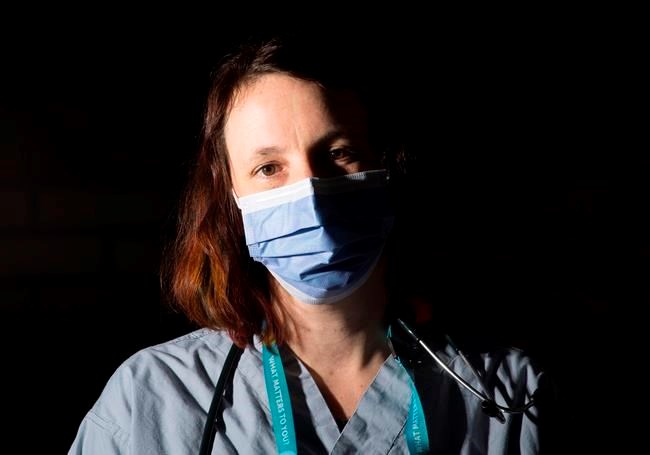By Amy Smart
VANCOUVER — As a registered nurse in the emergency department at St. Paul's Hospital in Vancouver, Zoe Manarangi Bake-Paterson wonders whether she'll be the same after the COVID-19 pandemic subsides.
There's palpable stress in the department, she says, as she and her colleagues prepare for a surge of cases that may or may not arrive.
"It feels like we're in a lifeboat in the ocean waiting for the tsunami to arrive," Manarangi Bake-Paterson says.
"I just wonder how this will change me or change my co-workers in our practice or in our personal lives, because I think it's a lot that's going to come our way. I just wonder, when we come through the other side, how different will we be?"
St. Paul's has long been at the forefront of treating Vancouver's most vulnerable.
In the 1980s, it was one of the few treatment centres for HIV-positive patients in British Columbia. Today, many of its patients are residents of the Downtown Eastside, which has been the epicentre of an overdose crisis.
More than a dozen health workers at the hospital agreed to be interviewed by The Canadian Press and described how the COVID-19 pandemic is affecting them and their work.
They shared feelings of uncertainty, fear, hopefulness and solidarity.
Even if B.C. is successful at slowing COVID-19's spread, several nurses say they are bracing for a possible outbreak in the Downtown Eastside where so many are homeless and physical distancing is a challenge.
The hospital is closed to anyone except patients and staff now.
Beds have been vacated and triage has been overhauled so that patients with respiratory symptoms can be isolated immediately.
Staff receive updated directions — sometimes hourly — as new evidence about the outbreak emerges. They rehearse urgent intubations after their shifts and adjust to working in zero pressure rooms.
Potential COVID-19 cases appear in the emergency department in many different ways.
"It kind of looks like pneumonia. They're short of breath, usually pretty high fevers and they tend to deteriorate pretty quickly, the people who are really not doing well," says registered nurse Duncan McTavish.
Other patients seem OK, so it's hard to tell, he says.
In some ways, the novel coronavirus is like a phantom in the emergency department.
Staff don't typically find out if a patient has COVID-19 after taking swabs. Patients may be sent home with instructions to manage their symptoms or be in intensive care by the time the test results come in.
The spectre that anyone could carry the virus has changed the way nurses think about everything they do.
"Every single action I take I have to think about," McTavish says. "What kind of mask I need and if I enter the room, swab this person, leave again — I have to make sure I've changed my gloves and washed my hands between every single step.
"We do that all the time, but certainly the awareness of that right now is really heightened."
Nurses wear goggles, suffocating surgical masks and other gear all through their shifts.
"People have been joking about how their skin is already feeling abrasions because of this constant friction with the masks," says Manarangi Bake-Paterson.
Registered nurse Rachel Mrdeza says she had never really thought about the gear she wears as protection, but now she's keenly aware that it's her shield.
Feelings in the hospital swing like a pendulum, she says.
On one side, staff are worried for patients and loved ones. On the other, they're uplifted by the roaring cheers for health workers that ripple through the city at the same time every night and by the donations of food and other supplies that have been dropped off.
"At those times it feels so incredibly joyous to experience that," Mrdeza says.
There's also a feeling of unity among staff.
"Even in the masks where you can't see people's smiles and glasses are fogged up and ... there is this physical disconnect, it feels like we're in this together," Manarangi Bake-Paterson says.
Many have had to make personal sacrifices or have had tough conversations with their families about what would happen if they got sick.
Registered nurse Leah Ventura says she waved hello outside her parents' window the other day because she couldn't go in.
Amanda Hickey, a clinical nurse leader, says her mother recently moved to a care home and Hickey hasn't been able to see her in more than a month.
"That's been really tough."
Registered nurse Maria Alonzo says her heart sank when she woke up one day with a body ache, fever and dry throat. One of the physicians she works with contracted the coronavirus and she's in contact with potential cases every day.
As a single mom who lives with her 73-year-old mother, Alonzo had trouble expressing the relief she felt when she tested negative.
"I actually cried when I got my result," she says. "Every time I go to work my fear is 200 per cent, because I always think of my son, my mom who lives with me. What would happen if I got sick?"
Still, Alonzo says she'll continue to work every day alongside thousands of other health workers.
In many ways, the emergency department nurses' jobs haven't changed at all. They are still responsible for providing the best care they can and they have a system in place to do so.
Registered nurse Erica Wong urges everyone to keep following public health protocols that will give nurses the best chance at success.
"So far we're doing OK, but that can change any second. Just continue to be cautiously optimistic. We are all in this together," she said.
"We just need to keep going."
This report by The Canadian Press was first published April 14, 2020



